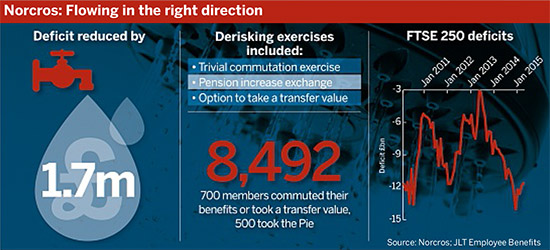Kitchen and bathroom accessories group Norcros has reduced its scheme deficit by £1.7m through a series of liability-management exercises, as pension funds see a further deterioration in funding levels.
Last week, data showed FTSE 250 pension schemes' collective deficit stood at around £12bn at the end of last year, deteriorating by £5bn year on year, according to consultancy JLT Employee Benefits.
Earlier this year, engineering and technology company Invensys carried out a suite of exercises in a three-pronged bid to derisk its pension scheme.
The Norcros scheme began consulting on a programme of derisking exercises back in 2013, having carried out an earlier pension increase exchange exercise in 2010.
The company led a trivial commutation exercise, pension increase exchange and offered deferred members the option of taking a transfer value.
The three-pronged approach reduced the scheme’s liability on a technical provisions basis by £6.8m, resulting in an overall £1.7m reduction in the scheme’s deficit.
Martin Payne, finance director at Norcros, said: “This obviously is a welcome move in the right direction to help reduce the deficit, but… the reduction in real bond yields during the year somewhat negated the impact of these exercises.”
The scheme’s March valuation showed its deficit on an 1AS 19 accounting basis had more than doubled during the year to £44.3m, up from £21.8m in 2014, due to a 0.7 per cent reduction in real yields during the year.
The company’s annual report showed strong asset growth during the year, with total scheme assets rising to £397m in March, up from £384m last year.
We would see it as a part of the ongoing governance structure now, that small exercises are happening on an ongoing basis as members reach retirement
Alan Collins, Spence and Partners
The scheme’s investment strategy and forward plan for further derisking remains under review following the completion of its triennial valuation in March.
Payne said: “[The] investment strategy is constantly under review and we are looking specifically at using [liability-driven investment] to take out further interest and inflation risk.”
Norcros’s defined benefit scheme closed to new members and future accrual in April 2013.
It has 8,492 members split evenly between pensioner and deferred members – and 700 members took up the option of either commuting their benefit or taking a transfer value, while approximately 500 took up the offer of a pension increase exchange.
Following the code
Richard Hennessy, partner in KPMG’s Manchester pensions team and adviser on the exercises, said the company had completed all communication and preparation work well before April 6 and saw no reason to delay the exercises following the 2014 Budget announcement.
“The take-up on all three was pretty in line with expectations. The Pie was slightly lower than expected but we think that’s because they did it five years ago; it was the second bite of the cherry.”
Ahead of the exercises Hennessy said the company worked carefully through each principle of the industry code of practice on incentive exercises and designed bespoke communications to ensure scheme members were fully informed of the options available to them.
“[The principles] fed into the offer, the design of the communications and the company paid for an [independent financial adviser],” he said.
“Members enjoyed the fact they’d been written to and then had a lot of support. Even for those who didn’t take it up, a lot of people got to speak to the IFA and engaged with it.”
Streamlining processes
Bob Scott, partner at consultancy LCP, said schemes should aim to merge liability management into communications with members prior to and at retirement.
“We’re seeing, with the pension freedoms, the first stage has been to look at retirement communications, and as people come up to retirement [ensuring] they are provided with information… actually making some of the liability-management stuff a part of the basic retirement process,” said Scott.
Alan Collins, director at consultancy Spence & Partners, anticipated the number of liability-management exercises would increase over the short to medium term and many of the processes involved would become streamlined.
“Over the last five years employers have done a sort of ‘big bang’ where they go and offer all the members a transfer value or a Pie,” Collins said.
“We would see it as a part of the ongoing governance structure now that small exercises are happening on an ongoing basis as members reach retirement… more a part of the year-on-year, month-on-month management of the scheme.”
However, Collins questioned the capacity of financial advisers to respond to a large uptick in exercises.
“Logistically, having a financial adviser able to advise potentially hundreds of members is… quite difficult. There are very few financial advisory firms in the UK that could carry off that scale,” he said.
“There’s a double-edged sword for financial advisers there – yes there’s a case for streamlining IFAs if they’re advising a number of members simultaneously, they can reduce costs at the edges, but fundamentally trustees and employers need to ensure that members get proper advice and that comes at a cost."














